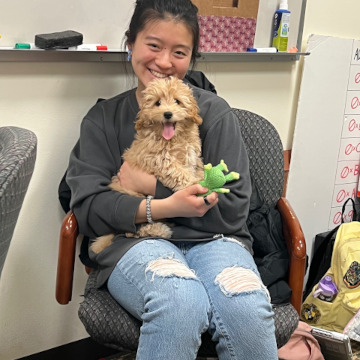Challenge 05: Selina's Medicine Bottles

As usual, Selina is having tummy troubles. Maybe she ate dairy despite having an intolerance1. Or maybe she ran around the lake despite not having eaten2. Or maybe she is stressed out because the instructor hasn't written that sixteenth letter of recommendation yet3. Or maybe she simply just ate at the dining hall4. Either way, her stomach is not happy and she needs to find some medicine to calm it down.
Unfortunately, Selina takes a lot of medication. Like, a lot. Perhaps too many. In fact, her backpack is a portable pharmacy5... a mini St. Liam's. Because she has so many medicine bottles, she decides to organize them according to the following rules.
-
Each bottle has three attributes:
medicationname, bottlesize, and pilltype.size: can besmall,medium, orlargetype: can begelortablet
-
She wants to group all the bottles of the same
typetogether withgelpills coming beforetabletpills. -
Within each
typeshe wants to arrange the bottles in ascending order alphabetically bymedicationname. -
If any of the bottles have the same
medicationname, then she wants to order them by in ascending order according tosize(i.e.small,medium, thenlarge).
Of course, she is too busy girlbossing to actually do the organization herself. Instead, she wants you to do the work for her so she can go socialize, take care of ducks, or play with Indy.
Input¶
You will be given a series of input test cases, each representing a collection of bottles you need to arrange according to the rules described above.
Each input test case will consist of two parts. The first line is an
integer n which denotes how many bottles there are in the collection. This
is then followed by a series of n bottles in the following format:
MEDICATION_NAME BOTTLE_SIZE PILL_TYPE
Here is an example input:
10
Omeprazole large gel
Metoprolol small gel
Clopidogrel medium tablet
Clopidogrel large tablet
Oxycodone large gel
Clopidogrel small tablet
Furosemide large tablet
Clonidine large tablet
Simvastatin medium tablet
Amoxicillin medium tablet
Note: As described above, each bottle can be one of three sizes:
small, medium, or large. Likewise, each bottle can be one of
two types: gel or tablet.
Output¶
For each input test case, you are to order the bottles as described above and then display a silhouette of the bottles in the cabinet in the ordered arranged.
For each bottle size, use the following letter to represent the bottle based on its size in the silhouette:
| small | . |
| medium | : |
| large | | |
Here is the output for the example input above:
.||:|.:||:
Arranging the input of bottles by the rules described above, would give the following sequence of bottles:
| Medication | Size | Type | Letter |
|---|---|---|---|
| Metoprolol | small | gel | . |
| Omeprazole | large | gel | | |
| Oxycodone | large | gel | | |
| Amoxicillin | medium | tablet | : |
| Clonidine | large | tablet | | |
| Clopidogrel | small | tablet | . |
| Clopidogrel | medium | tablet | : |
| Clopidogrel | large | tablet | | |
| Furosemide | large | tablet | | |
| Simvastatin | medium | tablet | : |
As can be seen, the bottles are arranged by pill type, then
alphabetically medication name, and then by bottle size.
Once arranged properly, simply combine all the letters corresponding to
the bottle sizes into a single line to form the silhouette and print
that out.
Algorithmic Complexity¶
For each input test case, your solution should have the following targets:
| Time Complexity | O(Nlog(N)), where N is the number of bottles for each input test case. |
| Space Complexity | O(N), where N is the number of bottles for each input test case. |
Your solution may be below the targets, but it should not exceed them.
Submission¶
To submit your work, follow the same procedure you used for Reading 01:
$ cd path/to/cse-30872-su23-assignments # Go to assignments repository
$ git checkout master # Make sure we are on master
$ git pull --rebase # Pull any changes from GitHub
$ git checkout -b challenge05 # Create and checkout challenge05 branch
$ $EDITOR challenge05/program.cpp # Edit your code
$ git add challenge05/program.cpp # Stage your changes
$ git commit -m "challenge05: done" # Commit your changes
$ git push -u origin challenge05 # Send changes to GitHub
To check your code, you can use the .scripts/check.py script or curl:
$ .scripts/check.py
Checking challenge05 program.cpp ...
Result Success
Time 0.62
Score 6.00 / 6.00
$ curl -F source=@challenge05/program.cpp https://dredd.h4x0r.space/code/cse-30872-su23/challenge05
{"result": "Success", "score": 6, "time": 0.6157994270324707, "value": 6, "status": 0}
Pull Request¶
Once you have committed your work and pushed it to GitHub, remember to create a pull request and assign it to the teaching assistant.